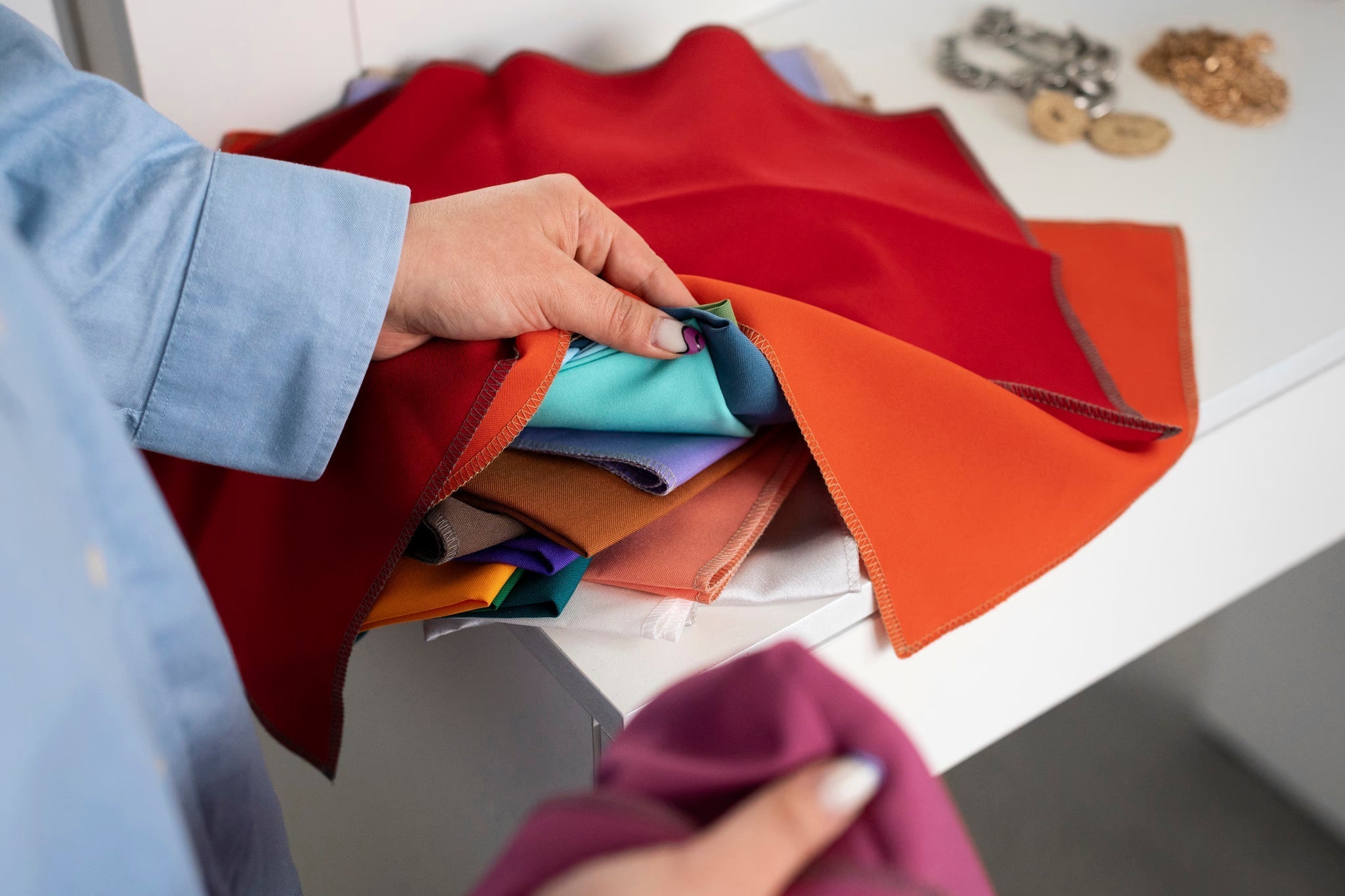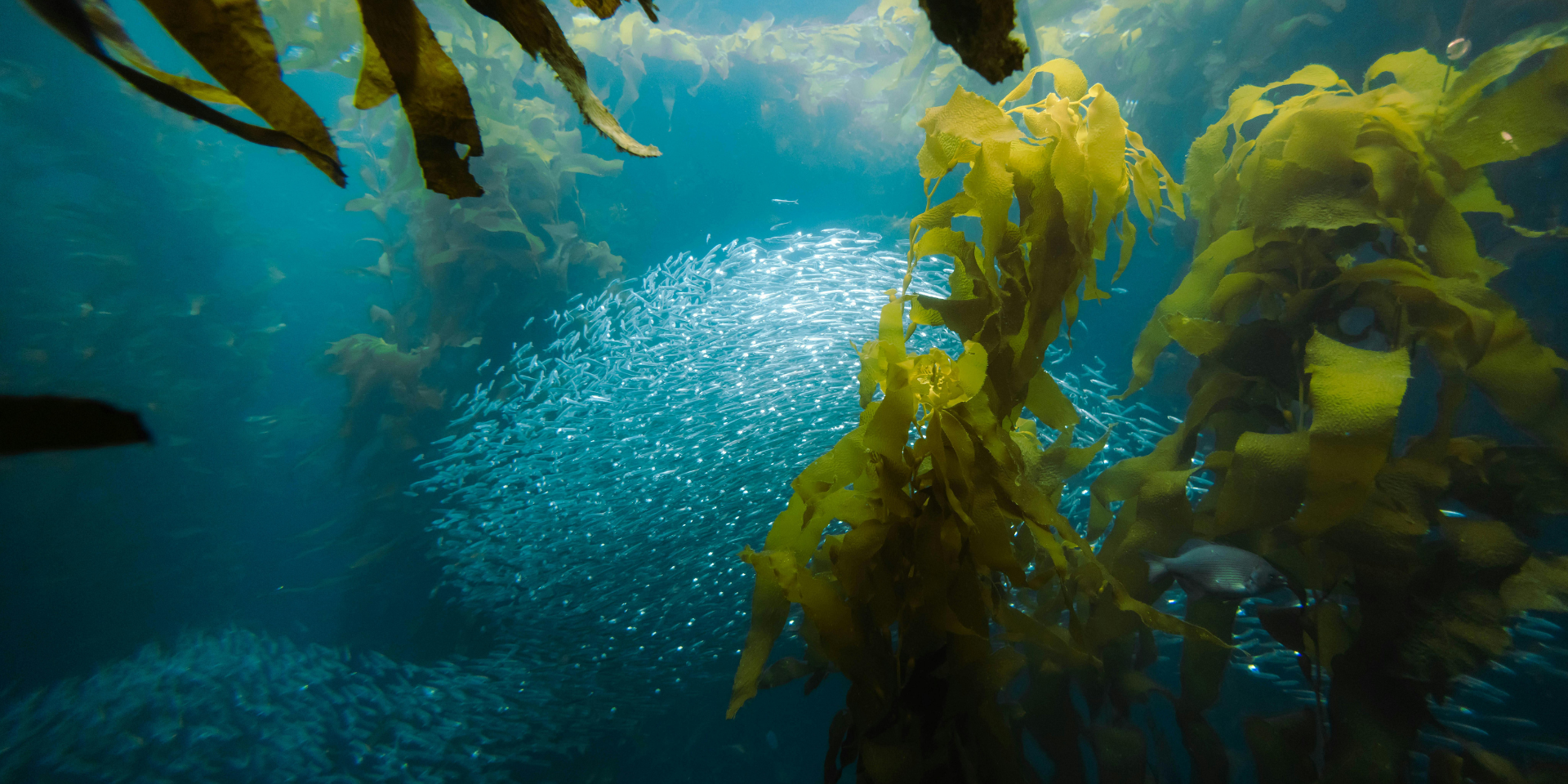It’s common to search for and find resources about how to choose the right clothing manufacturer for your business.
But what about the step before that, where so many get stuck trying to find the right material for their product development or manufacturing process?
The struggle to find—or switch—your textile supplier can feel overwhelming, not only because of the logistical hurdle, but mainly because of the complexity of the supply chain itself, which makes the process feel out of reach, too risky, or simply hard to start.
For instance, it can look like a maze of options: local fabric stores, online suppliers, wholesale markets, trade shows, and so on…
Regardless, no matter how you approach it, understanding the steps to find the right supplier is essential—whether you're a product developer, a designer, a brand owner, a procurement or sourcing manager.
Moreover, if your focus is sustainability, it can make the process more complex—because it asks you to look deeper, to zoom out, and really understand what you're sourcing and who you're sourcing it from.
But complex doesn’t mean impossible. And it’s worth it—for the kind of conscious brand you’re working to build.
Given all of this, why is having a sourcing strategy so important?
Of course, it’s always mattered. The supply phase has always been the foundation of the product development process.
But today, when it comes to building a responsible fashion business, the right supplier isn’t just a “nice to have” anymore—it’s a foundation. Because sourcing now means navigating much more than just fabric availability or price points.
Global supply chains are being reshaped by trade conflicts, shifting tariffs, rising pressure for traceability, and the long tail of climate and geopolitical disruptions.
Between tariffs, exceptions to tariffs, trade conflicts, new deals, and market speculation, it’s tough to really understand what’s actually going on with global industrial supply chains, let alone predict the future. - Kearney
In spite of that, sourcing decisions need to be strategic, always keeping in mind that the right supplier choice can help you build resilience, reduce risk, and maintain your brand’s integrity across every layer of production.
That said, if you’re ready to source more intentionally, but aren’t sure where to begin, keep reading.
We’re breaking down practical tips to help you choose the right textile supplier for your sustainable brand, with insights that support not just your next collection, but the future you’re building through it.
Define Your Business Sustainability Goals with Clarity and Purpose
Before you start reaching out to suppliers or comparing swatches, take a moment to zoom out.
What are your priorities when it comes to sustainable sourcing? Is it…
-
Certified organic or recycled materials? (Like GOTS, OEKO-TEX, RCS, GRS, etc.)
-
Low-impact fiber choices like hemp, TENCEL™ Lyocell, or 100% cotton?
-
Local or regional sourcing to reduce shipping emissions and support nearby economies?
-
Verified labor practices and clear visibility into worker conditions across tiers?
-
Achieving a necessary decarbonization level?
-
Low minimum order quantities (MOQs) that match your production scale?
These are just a few examples. Your priorities might include all of them—or entirely different ones.
Keep your mind open, and take time to understand what sustainability truly means when it comes to sourcing.
There’s no one-size-fits-all formula. The goal is alignment, because without it, you’ll be shooting in all directions and missing every target.
With a clear understanding of your sourcing goals, you can start aiming with intention and making choices that actually move your brand forward.
In other words, you need to turn your values, goals, and vision into sourcing criteria. That means, filters that help you find suppliers who are genuinely compatible with your business model.
A practical example of this in action:
Instead of a broad goal like “I want to support ethical production,” aim for something more specific and actionable, such as:
“I’m sourcing from suppliers that provide third-party verified labor audits and offer transparency beyond Tier 1.”
This level of clarity not only sharpens your sustainability goals but also helps narrow your supplier search. You’ll be more focused, efficient, and better equipped to take the next step with confidence.
Clarifying Responsible vs. Sustainable
In this goal-alignment phase, it’s also important to get clear on your terms—especially if you're aiming for sustainable sourcing or responsible sourcing. Yes, there’s a difference, and understanding it is crucial before defining your strategy. Thus, according to the Committee on Sustainability Assessment (COSA):
→ Responsible Sourcing requires meeting or complying with accepted levels of ethical or responsible practices in areas such as human rights, deforestation, or pollution; although having great intrinsic merit, they do not amount to sustainable conditions among suppliers and can even be an additional unremunerated cost.
→ Sustainable Sourcing embraces and also goes beyond compliance to also engage with suppliers and markedly improve or move toward achieving the conditions of sustainability.
To sum up: the more specific you are, the easier it becomes to identify the right partners, and to build a sourcing process that’s clear, intentional, and scalable.
This doesn’t mean you need to tick every box from day one. But it does mean getting clear about what matters most, right now, for the brand you’re trying to build.
Before You Search Elsewhere, Audit What You Already Have
Before diving headfirst into finding a new supplier, it’s worth pausing to ask: Are your current partners aligned with where your brand is headed?
As your standards evolve—mostly around sustainability, transparency, and responsible sourcing—it’s important to check whether the suppliers you’ve relied on are evolving with you.
Sometimes, the relationship just needs a reset. Other times, it might be time to move on. Either way, the first step is getting clear on what’s working and what isn’t.
Here’s a quick supplier audit to guide your review:
-
Are their certifications valid and up to date?
-
Do they offer real transparency around fiber origin, dyeing processes, labor conditions, and environmental practices?
-
Can they scale with your business as you grow—or meet lower MOQs if you’re still building?
-
Are they open and timely in their communication when problems arise?
-
Do they align with your core values—not just on paper, but in practice?
These are just a few of the red flags you need to be have your eyes on. In addition, whether you're reaching out for the first time or reassessing an existing supplier, here are key questions to help you dig deeper.
|
Category |
What to Ask the Supplier |
Why It Matters |
|---|---|---|
|
Fiber Origin & Input |
What are the exact raw materials used, and where were they grown or sourced? |
Helps assess traceability and potential environmental/social impacts at origin (e.g. deforestation, forced labor). |
|
|
Is the fiber certified? Can you share the current certificate with transaction number? |
Verifies authenticity of sustainable claims and avoids greenwashing. |
|
Processing & Chemicals |
What kind of chemical processing was used in dyeing/finishing? Are verified standards followed? |
Assesses toxicity risks and water pollution impact. |
|
|
Are any restricted substances used? Can you share your MRSL and RSL compliance levels? |
Critical for compliance with brand policies and global regulations (like REACH). |
|
Water & Energy |
How much water and energy is typically used per meter of this fabric? Is it measured or estimated? |
Encourages transparency on impact and distinguishes between efficient vs. resource-heavy mills. |
|
|
Is any of your production powered by renewable energy? |
Enables comparison between low- and high-carbon options. |
|
Labor & Social |
Can you describe your labor conditions? Do you have social certifications (e.g. SA8000, SMETA)? |
Ensures ethical labor standards and reduces risk of labor violations in the supply chain. |
|
Waste & Circularity |
Do you offer take-back or recycling options for offcuts or post-consumer returns? |
Supports circularity goals and reduces landfill burden. |
|
|
What % of production waste is recycled or reused onsite? |
Helps brands measure supplier efficiency and reduce upstream waste. |
|
Performance & Quality |
How does this fabric perform in terms of durability, colorfastness, pilling, shrinkage, etc.? |
Clarifies real-life usability and reduces risk of overproduction due to replacements. |
|
|
Can you provide lab test reports or performance data? |
Evidence-based proof helps buyers trust what they're sourcing. |
|
Minimums & Lead Times |
What are the MOQs for sampling and bulk? What are your standard lead times and flexibility options? |
Many sustainable mills have high MOQs—critical for SMEs to negotiate or assess feasibility. |
|
|
Do you offer stock service or only made-to-order production? |
Affects design timeline and responsiveness to seasonal or small-run demands. |
|
Transparency & Documentation |
Can you provide a full traceability map or digital passport for this fabric? |
Supports LCA, CSRD, and consumer-facing transparency. |
|
|
How often are your sustainability claims audited by a third party? |
Reduces greenwashing risk and builds trust. |
|
Brand Use & Marketing |
Can your certification and sustainability story be shared in consumer-facing marketing? |
Helps brands use supplier data to support product storytelling without legal risk. |
|
|
Do you provide visuals, data, or stories about your mill, workers, or processes that we can use (with permission)? |
Offers content for impact marketing and deeper supplier-brand connection. |
So before you go searching elsewhere, consider having an honest conversation with your current suppliers. Share where your brand is headed, ask about their capabilities, and see where there’s room to grow—together.
The right supply chain partner can take your business to the next level. But the wrong one? It can stall growth, hurt your reputation, or block access to global markets. — Quote from Signs It’s Time to Rethink Your Fashion Supply Chain Partner
Remember you are Vetting for More Than Just Materials

Don’t forget—your supplier should be a long-term partner, not just a part-time problem solver.
Since last year, industry leaders have been increasingly vocal about the importance of supplier partnerships.
In a 2024 article, The Business of Fashion emphasized that one of the most critical ways fashion executives should respond to the shifting landscape of global trade (which gained even more traction in 2025) is to:
Rethink the approach to manufacturers and suppliers, with an emphasis on developing long-term strategic partnerships to increase the efficiency and resilience of supply chains.
In their 2025 State of Fashion report, co-published with McKinsey & Company, they outlined one of the top priorities for fashion executives this year: “Collaborate closely with suppliers by establishing strategic relationships, prioritizing data transparency, and co-investments to jointly build resilient and productive supply chains.”
The message is clear:
Strong supplier partnerships is, today, an essential infrastructure. And in a world where agility, traceability, and shared accountability matter more than ever, building that kind of relationship from the start is one of the smartest moves a fashion player can make.
To make that possible, modern digital sourcing tools are the bridge, connecting both ends through real-time data, shared visibility, and faster communication.
But more on that in a bit—keep reading.
Where to Look for Fabrics and How to Do It Smarter
Once you’ve clarified your sourcing goals—what you value, what you need, and what your supply chain should stand for—the next step is figuring out where to actually look for the right supplier.
This is where things can start to feel overwhelming, mainly because there’s no shortage of options today. From local wholesalers and fabric stores to massive trade shows and online sourcing methods, the supply landscape is not only wide, but fragmented.
And without a clear filter, it’s easy to get stuck in research mode, or worse, waste time chasing leads that don’t fit your needs.
Let’s break it down.
In-Person Sourcing: Fairs, Expos, and the Value of Showing Up
On one hand, trade shows and textile expos can be valuable—especially if you’re looking to make personal connections, build relationships, and get hands-on with materials.
Events like Première Vision or Future Fabrics Expo are great ways to experience what's happening across the industry and meet suppliers face-to-face.

On the other hand, if you're just starting out, or trying to scale a conscious brand, this route comes with challenges: you will be tied to event calendars, and traveling can become expensive and time-consuming—you might find yourself needing to travel halfway across the world just to stay on track with the right events.
However, that doesn’t mean they’re not valuable, because they are.
Even digital sourcing platforms like World Collective show up at trade events. This June (24–25), for example, the team will be at FFE London, joining the Innovation Hub to connect with suppliers and brands face-to-face—while continuing to offer one of the most robust and accessible digital sourcing ecosystems in the industry.

Local textile stores are another in-person option—but they rarely carry sustainable or certified materials. And when they do, it’s often difficult to access the documentation, traceability, or consistency needed for scaling.
So while they can be an easy, accessible resource early in your sourcing journey, they’re not the most reliable go-to for building a responsible supply chain.
Narrowing Your Search Starts with Knowing Your Materials
Before you dive into sourcing—online or in person—you need to narrow your focus. That means knowing what kind of textiles you're actually looking for.
Because if you don’t know the material you’re sourcing, every platform or showroom becomes a maze.
This may sound obvious, but it’s a critical filter most early-stage brands skip. As fashion influencer Stephanie, founder of the Start Your Fashion Business YouTube channel, says:
Where to start looking? The best way to do that is to really know what fabrics you’re looking for—what type of fabric. Because you have knits, woven… So many different fabrics. So you have to be able to narrow it down.
Her tip? Use those fabric categories as your keywords, both when reaching out to suppliers and when searching online.
However, it’s important to note: online sourcing won’t be effective—or make your life easier—if you’re not using it strategically. Even with the right keywords, falling down the Google rabbit hole isn’t a great strategy.
Smart Online Sourcing: Why Digital Textile Ecosystems Are the Future
Today’s sourcing pace demands digital tools that can keep up—and smart online sourcing strategies. In especial if you’re trying to build a responsible supply chain and source conscious materials.
It’s one thing to type "sustainable cotton supplier" into Google. It’s another to end up on disconnected websites, contacting random emails, or gathering 10 leads you can’t verify.
What conscious brands need now are trusted places to focus their search: digital sourcing ecosystems—curated, centralized platforms that bring verified suppliers, certifications, product data, and sampling workflows into one place. With them, you can:
- Access Traceable & Certified Sustainable Fabrics
- Get Real-Time Inventory & Supply Chain Insights
- Simplify Sourcing with All-in-One Digital Transactions
- Source from Transparent & Verified Suppliers—from All Around the World
- Have Access to Innovative Sustainable Textiles
- Build a Scalable, Digital Sourcing Infrastructure
And all that, of course, if you choose the right digital sourcing ecosystem.
But one advantage deserves to be highlighted: the ability to diversify your sourcing in a seamless, efficient way. And in today’s global context, that’s more important than ever.
As Bain’s Claudia D’Arpizio noted in a January 2025 interview with Vogue Business:
Diversifying across multiple hubs can reduce reliance on a single market while balancing the strengths of various sourcing regions. Leveraging advanced technologies, such as AI-driven supply chain systems, can further optimize production, minimize waste and improve logistics in regions with less-developed infrastructure.
Her point still holds. While the trade environment may feel more stable than it did a few months ago, we’re still navigating global uncertainty—and fashion’s sourcing landscape can shift overnight. That’s why today’s sourcing models need to be resilient, digitally connected, and flexible enough to adapt in real time.
Other Sourcing Methods: Getting Third-Party Help
Not every brand has the time, bandwidth, or internal know-how to source materials directly. And that’s okay. There are professionals whose job is to help with exactly that.
Fabric Sourcing Agents
These are intermediaries who specialize in finding fabrics that meet your specifications—whether that’s fiber content, certification, price point, or lead time. They typically have established relationships with mills and can help you cut through the noise quickly.
-
Why it can work:
-
Saves time when you don’t know where to start
-
Often have insider access to mills and suppliers
-
Can negotiate on your behalf
-
-
But keep in mind:
-
Agents vary in quality and transparency
-
You’re adding another layer between you and your supplier
-
It may be harder to validate sustainability claims firsthand
-
If transparency is a core part of your brand, you’ll need to make sure your agent shares those standards—and is willing to open up the supply chain, not gatekeep it.
Full-Package Manufacturers (FPP)
FPPs often handle everything from fabric procurement to pattern development, sampling, and final production. This can be a great option for early-stage brands looking for operational simplicity.
-
Why it can work:
-
You get an end-to-end partner
-
Simplifies communication and project management
-
Often includes built-in sourcing support
-
-
But here’s the tradeoff:
-
Less control over material choices
-
Limited visibility into upstream supply chain (fiber, dyeing, labor practices)
-
Potential minimums or margins that don’t suit smaller brands
-
However, you don’t have to rely on third parties if you have the right sourcing ecosystem.
Platforms like World Collective give you direct access to vetted suppliers—with clear data on certifications, traceability, lead times, and pricing—so you can source with the same precision and speed, but with full visibility and ownership.


